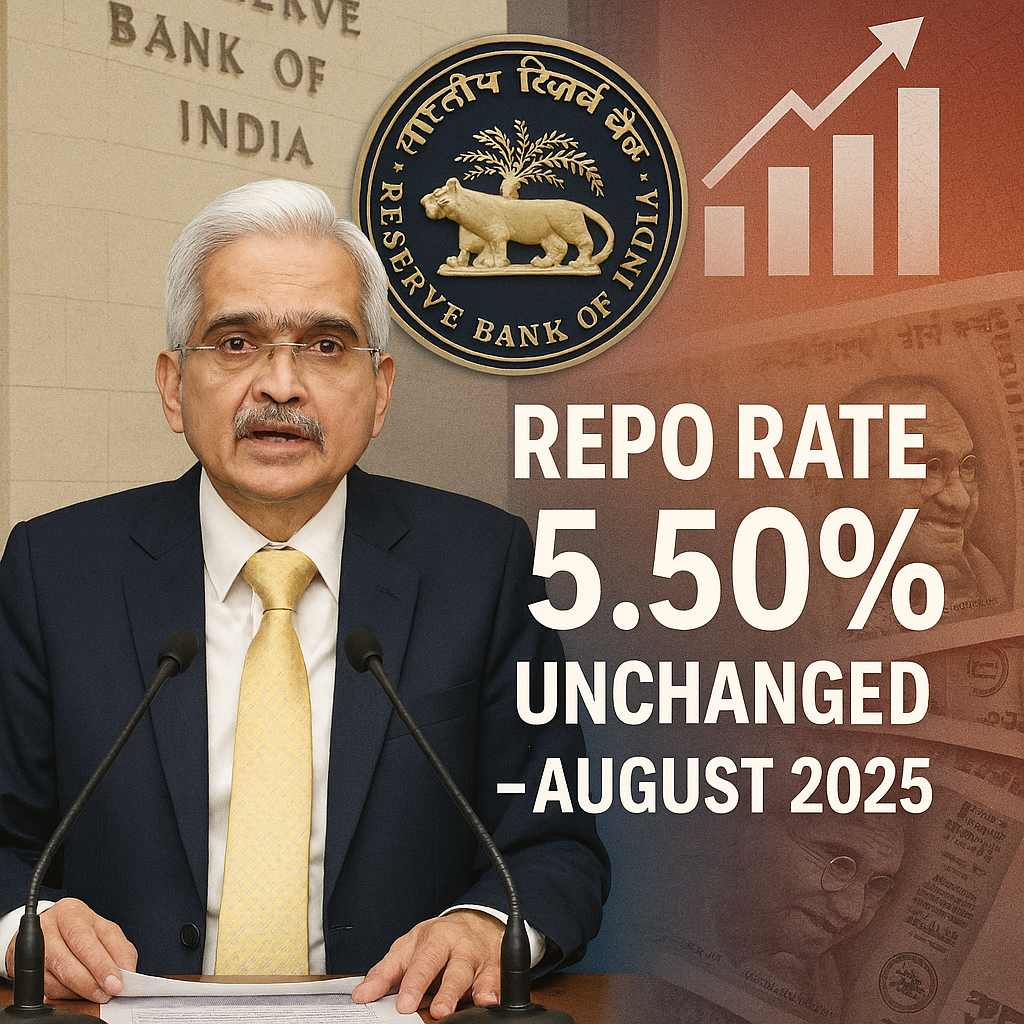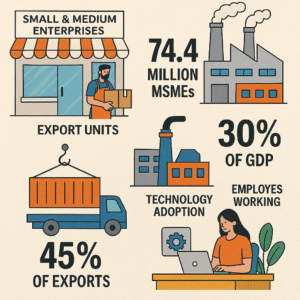
RBI Monetary Policy August 2025: Repo Rate Unchanged at 5.50%

The RBI kept the repo rate unchanged at 5.50%, citing global economic uncertainties and inflation risks. Here’s a detailed analysis of today’s RBI policy, implications for borrowers, markets, and what’s ahead.
Table of Contents
Published: August 06, 2025 | Last Updated: August 06, 2025
The Reserve Bank of India’s Monetary Policy Committee concluded its three-day meeting on August 6, 2025, with a decision to maintain the repo rate at 5.50 percent. This marks a pause in the rate-cutting cycle after cumulative reductions of 100 basis points earlier in the year.
The decision reflects the central bank’s approach to balancing growth support with inflation management. Governor Sanjay Malhotra led the committee through deliberations that considered both domestic economic conditions and external pressures from global trade tensions.
Financial markets responded with measured optimism to the announcement. The BSE Sensex gained 214 points following the policy declaration, with banking and real estate stocks showing strength.
Policy Rate Structure Remains Unchanged
The Monetary Policy Committee voted to keep all key policy rates at their current levels. The repo rate, which determines the cost at which commercial banks borrow from the central bank, stayed at 5.50 percent.
The reverse repo rate remained at 3.35 percent, maintaining the corridor between lending and deposit rates. This structure provides banks with guidance on their own lending and deposit rate decisions.
Other monetary policy instruments also remained static. The Cash Reserve Ratio stayed at 3.50 percent, while the Statutory Liquidity Ratio held at 18.00 percent. The Bank Rate and Marginal Standing Facility Rate both remained at 5.75 percent.
Meeting Schedule and Committee Composition
The MPC convened over three consecutive days from August 4 to August 6, 2025. This extended schedule allowed for comprehensive review of economic data and financial market conditions.
Committee members included Dr. Nagesh Kumar, Shri Saugata Bhattacharya, Prof. Ram Singh, Dr. Poonam Gupta, and Dr. Rajiv Ranjan. Each member brought specialized expertise to the policy deliberations.
The voting pattern showed four members supporting the status quo position. Two members advocated for rate changes, though the majority prevailed in favor of maintaining current rates. The committee also agreed to continue the neutral monetary policy stance adopted in June 2025.
Rate Cut History in 2025
The central bank implemented significant monetary easing in the first half of 2025. In February, the MPC reduced rates by 25 basis points, lowering the repo rate from 6.00 percent to 5.75 percent.
A second 25 basis point cut followed in April 2025. This brought the repo rate down to 5.50 percent, representing the first 50 basis points of easing.
The June 2025 meeting saw an additional 50 basis point reduction. This brought the total easing to 100 basis points over a four-month period, a substantial monetary policy shift.
Rationale for August Pause
Economic analysts had anticipated the August decision to maintain rates. The frontloading of 100 basis points in cuts across three consecutive meetings suggested the need for a pause to assess policy impact.
The central bank needed time to evaluate how the earlier rate reductions were affecting credit growth, consumption patterns, and investment decisions. Monetary policy operates with lags, meaning the full effects of rate cuts take several months to materialize.
Global economic conditions also warranted caution. Trade tensions and tariff uncertainties created risks that required careful monitoring before implementing further policy changes.
Economic Growth and Inflation Projections
The Reserve Bank maintained its GDP growth forecast for fiscal year 2025 at 6.8 percent. This projection reflects confidence in domestic consumption and investment activity despite external headwinds.
Governor Sanjay Malhotra expressed optimism about India’s growth potential. He stated that the country can achieve growth rates exceeding 7 percent, emphasizing that such targets should be national aspirations.
The committee revised inflation projections upward for FY25. Consumer Price Index inflation is now expected at 5.6 percent, higher than previous estimates.
Factors Influencing Inflation Outlook
Food price pressures remain a key concern for inflation management. Monsoon rainfall patterns and their impact on agricultural production directly affect food inflation trajectories.
Core inflation, which excludes volatile food and fuel prices, is expected to moderate gradually. This provides some offset to food price concerns, though overall inflation remains above the RBI’s medium-term target of 4 percent.
Supply chain disruptions and global commodity price fluctuations add uncertainty to inflation forecasts. Energy costs, particularly crude oil prices, continue to influence both headline and core inflation measures.
Global Economic Context and Challenges
International trade tensions present significant challenges for India’s export-oriented sectors. The United States has implemented substantial tariff increases on various product categories, including a 50 percent tariff on certain Indian exports.
Governor Malhotra acknowledged the difficulty in predicting tariff impacts. The evolving nature of trade policies creates planning challenges for businesses and policymakers alike.
Commodity markets continue experiencing volatility across multiple categories. Crude oil prices affect India’s import bill and inflation dynamics, given the country’s dependence on energy imports.
Central Bank Policy Coordination
The Federal Reserve’s monetary policy decisions influence capital flows to emerging markets including India. Interest rate differentials between countries affect investor allocation decisions and currency markets.
The RBI’s policy approach occurs within the context of broader emerging market dynamics. Coordination with other BRICS economies and regional partners helps maintain financial stability amid global uncertainties.
Currency market stability remains a priority for the central bank. Adequate foreign exchange reserves provide a buffer against external shocks and support exchange rate management.
Banking Sector Implications
Commercial banks benefit from the stable interest rate environment. The unchanged repo rate allows banks to maintain their lending rate structures without frequent adjustments.
Net interest margins, the difference between lending and deposit rates, remain relatively stable. This provides predictability for bank profitability planning and resource allocation decisions.
Credit growth patterns show variation across segments. Personal lending continues expanding, while corporate credit demand shows gradual recovery after a period of subdued borrowing.
Sector-Specific Credit Trends
Micro, Small and Medium Enterprise financing receives continued focus from both lenders and policymakers. These businesses represent a significant portion of employment and economic activity.
Infrastructure project financing benefits from long-term rate stability. Large capital projects require multi-year planning horizons, making predictable financing costs valuable.
Retail lending segments including home loans, vehicle financing, and personal loans show sustained growth. Consumer confidence in employment and income prospects supports this borrowing activity.
Real Estate and Housing Market Impact
Home loan borrowers with floating interest rates see no immediate change in their Equated Monthly Installments. Banks may still adjust their benchmark rates based on liquidity conditions and competitive positioning.
The residential real estate sector continues showing momentum in major urban centers. Affordable financing costs support first-time homebuyer activity and housing demand.
Commercial real estate development projects benefit from financing cost predictability. Office space, retail properties, and industrial facilities require long planning periods that favor stable interest rate environments.
Construction and Infrastructure Development
Large infrastructure projects across roads, railways, ports, and urban development continue progressing. Government infrastructure spending programs receive support from stable financing conditions.
The construction sector employment trends influence both urban and rural labor markets. Infrastructure development creates direct employment and generates demand for building materials and services.
Real estate investment trusts and structured financing vehicles gain from the stable rate environment. These financial instruments provide alternative investment options for both domestic and international investors.
Consumer Finance and Retail Sector Effects
Consumer durable goods financing remains accessible at relatively stable costs. White goods purchases, electronic items, and furniture buying often involve credit arrangements.
Credit card usage and personal loan demand reflect consumer confidence levels. The stable interest rate environment supports continued growth in consumer credit segments.
Rural consumption patterns depend partly on agricultural income stability and credit availability. Monsoon performance and crop prices directly affect purchasing power in rural areas.
Digital Lending and Fintech Growth
Technology-enabled lending platforms continue expanding their market presence. Digital disbursement methods and alternative credit assessment models reach previously underserved segments.
Buy Now Pay Later services have grown substantially in e-commerce transactions. These short-term credit facilities appeal to younger consumers and support online retail growth.
Peer-to-peer lending platforms and marketplace lending continue developing within regulatory frameworks. These alternative financing channels provide options beyond traditional banking relationships.
Fixed Income and Deposit Rate Outlook
Term deposit rates at banks are expected to remain relatively stable following the policy decision. Some institutions may adjust rates based on their specific liquidity requirements and competitive strategies.
Senior citizens, who often depend on fixed deposit income, face a stable but moderate interest rate environment. Banks typically offer preferential rates to this demographic segment.
Corporate treasury departments managing short-term cash positions benefit from rate predictability. Business cash management decisions become easier with reduced interest rate volatility.
Bond Market Response
Government securities markets showed limited movement following the policy announcement. Bond traders had largely anticipated the decision to maintain rates given recent economic data.
Corporate bond markets continue functioning with stable pricing frameworks. Investment-grade issuers maintain access to debt capital at reasonable costs for business expansion needs.
Foreign portfolio investors in Indian debt securities consider multiple factors including interest rate differentials, currency expectations, and global risk appetite. The stable policy environment supports continued foreign participation in Indian bond markets.
Equity Market Reaction and Sector Performance
The BSE Sensex registered a 214-point gain following the policy announcement. This positive response reflected market approval of the central bank’s measured approach.
Banking stocks outperformed the broader market indices. Stable net interest margins and credit growth prospects support investor confidence in the banking sector.
Real estate company shares also showed strength post-announcement. Continued affordable home loan rates support housing demand and developer revenue prospects.
Sector-Wise Analysis
Consumer goods companies face mixed implications from the policy decision. Demand stability is supported by accessible credit, while input cost inflation remains a concern.
Infrastructure and capital goods stocks responded positively. Government infrastructure spending programs and stable project financing costs benefit these sectors.
Information technology services companies operate largely in export markets. Domestic monetary policy has limited direct impact, though macroeconomic stability supports business confidence.
Agricultural Sector Considerations
Farm credit availability at reasonable rates remains important for agricultural productivity. Crop loans fund seasonal working capital needs for planting, inputs, and labor.
Monsoon rainfall distribution across different geographic regions directly affects agricultural output. The southwest monsoon performance influences both Kharif crop production and subsequent Rabi season preparations.
Food price stability connects agricultural income with urban consumer inflation. This creates complex policy trade-offs between farmer income support and inflation management.
Allied Agricultural Activities
Dairy farming, poultry operations, and aquaculture require credit access for working capital and investment. These allied sectors contribute significantly to rural incomes beyond traditional crop farming.
Agricultural equipment financing supports mechanization and productivity improvements. Tractors, harvesters, and irrigation equipment often involve credit arrangements.
Horticulture and specialty crops require different financing approaches than staple food grains. Value-added agricultural activities often need working capital for storage, processing, and marketing.
State-Level Economic Impacts
Maharashtra, home to India’s financial capital Mumbai, benefits from stable monetary policy through enhanced business confidence. The state’s diverse economy spans finance, manufacturing, and services.
Karnataka’s technology sector in Bangalore gains from predictable financing costs. Startup ecosystem development and corporate expansion plans benefit from reduced interest rate uncertainty.
Tamil Nadu’s manufacturing industries including automotive, textiles, and engineering goods require stable input costs. The state’s industrial base responds to both domestic demand and export opportunities.
Regional Development Patterns
Gujarat’s chemical, pharmaceutical, and manufacturing sectors gain from policy stability. The state’s port infrastructure and industrial clusters attract domestic and foreign investment.
Uttar Pradesh and Bihar, with large agricultural sectors and growing manufacturing presence, benefit from rural credit availability and infrastructure financing.
Southern and western states generally show higher financial inclusion metrics. Banking penetration and credit access vary significantly across different regions and demographic groups.
Technology and Digital Economy Considerations
India’s expanding fintech sector operates within evolving regulatory frameworks. Stable monetary policy provides a predictable environment for business model development and scaling.
Digital payment systems continue growing rapidly across urban and rural areas. UPI transactions and mobile banking adoption support financial inclusion objectives.
E-commerce platforms benefit from consumer credit availability and digital payment infrastructure. Online retail growth connects to both urban consumer spending and digital adoption trends.
Cryptocurrency and Digital Assets
Regulatory frameworks for digital assets continue developing. The central bank and financial regulators work to balance innovation with investor protection and financial stability concerns.
Blockchain technology applications beyond cryptocurrencies receive attention from both private sector and government initiatives. Supply chain management, identity verification, and record-keeping represent potential use cases.
International Trade and Investment Climate
Export competitiveness depends on multiple factors including exchange rates, production costs, and market access conditions. Trade policy uncertainties create challenges for forward planning.
Key export sectors including information technology services, pharmaceuticals, textiles, and engineering goods face varying market conditions. Each industry segment responds to specific demand drivers and competitive factors.
Foreign Direct Investment inflows support capital formation and technology transfer. India’s demographic profile, growing consumer market, and reform initiatives attract international investors.
Supply Chain Resilience
Businesses continue efforts to diversify supply sources and reduce dependence on single-country suppliers. Recent global disruptions highlighted supply chain vulnerability risks.
Manufacturing capacity development under production-linked incentive schemes aims to boost domestic production. Electronics, pharmaceuticals, and other priority sectors receive policy support.
Quality standards and international certifications help Indian manufacturers access global markets. Meeting buyer requirements in different markets requires continuous capability enhancement.
Risk Management and Financial Stability
The Reserve Bank monitors systemic risks across the financial system. Banking sector health, capital market stability, and corporate leverage levels receive regular assessment.
Asset quality in the banking system has shown improvement in recent quarters. Non-performing asset ratios have declined from peak levels, though monitoring continues.
Capital adequacy ratios at banks remain above regulatory requirements. Strong capitalization supports credit growth capacity and provides buffers against potential losses.
Macroprudential Policy Tools
The central bank uses various tools beyond interest rates to manage financial stability risks. Loan-to-value ratios, sector-specific lending limits, and countercyclical capital buffers represent additional policy instruments.
Regulatory supervision of non-banking financial companies receives attention given their growing role in credit intermediation. Shadow banking risks require monitoring to prevent systemic vulnerabilities.
Forward-Looking Monitoring Areas
The October 2025 MPC meeting will consider several evolving factors. Monsoon impact assessment on agricultural production and food prices represents a key input.
Global economic developments including U.S. Federal Reserve policy decisions influence capital flow dynamics. International interest rate movements affect emerging market investment allocation.
Domestic consumption trends during the festive season provide insights into demand conditions. Festival period spending indicates consumer confidence and purchasing power.
Data Points Under Review
High-frequency economic indicators including GST collections, railway freight traffic, and automobile sales provide real-time economic activity signals. These metrics help assess momentum between quarterly GDP releases.
Manufacturing and services sector purchasing manager indices indicate business activity levels and confidence. Both domestic demand and export orders factor into these forward-looking indicators.
Labor market conditions including employment generation and wage growth affect consumption patterns. Organized sector employment data and rural wages provide different perspectives on income trends.
Policy Communication and Transparency
The Reserve Bank’s communication strategy emphasizes data-driven decision making. Policy statements provide detailed rationale for decisions along with economic assessments.
Press conferences following policy meetings allow Governor Malhotra and other officials to explain decisions and answer media questions. This dialogue enhances policy understanding among stakeholders.
Periodic publications including the Monetary Policy Report provide comprehensive analysis of economic conditions. These documents support transparency and accountability in central banking.
Stakeholder Engagement
Regular interactions with banks, financial institutions, and market participants inform policy development. The central bank receives feedback on ground-level conditions and emerging issues.
Academic and research institution engagement supports analytical capacity. Economic modeling, forecasting techniques, and policy evaluation benefit from collaborative research.
International Economic Integration
India’s participation in G20, IMF, and World Bank forums connects domestic policy to global economic governance. Multilateral cooperation supports financial stability and development objectives.
Regional trade agreements and economic partnerships influence trade flows and investment patterns. Negotiation of favorable terms requires balancing multiple domestic and international interests.
Currency swap arrangements with other central banks provide liquidity support mechanisms. These facilities help manage potential foreign exchange market pressures.
Cross-Border Capital Flows
Foreign portfolio investment in equity and debt markets responds to relative return expectations and risk perceptions. Policy stability and economic growth prospects influence investor decisions.
External commercial borrowing by Indian companies provides alternative funding sources. Access to international capital markets depends on credit ratings and market conditions.
Conclusion
The Reserve Bank of India’s decision to maintain the repo rate at 5.50 percent in August 2025 reflects a measured approach to monetary policy. Following 100 basis points of cumulative rate cuts earlier in the year, the pause allows assessment of policy transmission.
Economic growth projections of 6.8 percent for FY25 indicate continued expansion despite global headwinds. The upward revision of inflation forecasts to 5.6 percent acknowledges price pressures that require monitoring.
Financial markets responded positively to the policy decision, with equity indices gaining and banking stocks outperforming. The stable interest rate environment supports various sectors from real estate to consumer finance.
Looking ahead, the October 2025 MPC meeting will incorporate additional data on monsoon impacts, global developments, and domestic consumption trends. The central bank’s framework balances growth support with inflation management amid an uncertain global environment.
About the Author
Nueplanet
Financial Markets Analyst with the years of experience covering monetary policy, banking sector developments, and macroeconomic trends. Committed to providing accurate, well-researched analysis based on official sources including RBI publications, SEBI filings, and stock exchange data.
Nueplanet maintains independence and does not provide investment advice. All content is for informational purposes only, based on publicly available official sources.
Frequently Asked Questions (FAQs)
What is the current repo rate set by RBI?
The Reserve Bank of India maintained the repo rate at 5.50 percent during its August 6, 2025 Monetary Policy Committee meeting. This represents no change from the previous policy meeting in June 2025. The repo rate determines the interest rate at which commercial banks borrow short-term funds from the central bank.
How much has RBI cut interest rates in 2025?
The RBI has cumulatively reduced the repo rate by 100 basis points since February 2025. This includes a 25 basis point cut in February (from 6.00% to 5.75%), another 25 basis point reduction in April (to 5.50%), and a 50 basis point cut in June. The August meeting paused this rate-cutting cycle.
What is RBI’s GDP growth forecast for India?
The Reserve Bank of India has maintained its GDP growth projection at 6.8 percent for fiscal year 2025. Governor Sanjay Malhotra expressed confidence that India can achieve growth rates exceeding 7 percent. The FY26 outlook anticipates continued economic expansion above 7 percent if domestic and global conditions remain supportive.
Why did RBI pause rate cuts in August 2025?
The decision to maintain rates followed significant monetary easing in previous meetings totaling 100 basis points. The central bank needed time to assess the impact of earlier rate reductions on credit growth, consumption, and investment. Additionally, upward inflation revisions to 5.6 percent and global economic uncertainties including trade tensions warranted a cautious approach.
What is RBI’s current inflation projection?
The Reserve Bank revised its consumer price inflation projection for FY25 upward to 5.6 percent. This is above the central bank’s medium-term target of 4 percent. Food price pressures from monsoon variability and global commodity price fluctuations contribute to elevated inflation expectations. Core inflation is expected to moderate gradually over the forecast period.
How did stock markets react to the RBI policy decision?
The BSE Sensex gained 214 points following the policy announcement on August 6, 2025. Banking stocks led the rally, benefiting from stable net interest margin outlook and credit growth prospects. Real estate companies also performed well due to continued affordable home loan rates supporting housing demand. Bond yields remained relatively stable as the decision was largely anticipated by market participants.
Who are the members of the RBI Monetary Policy Committee?
The Monetary Policy Committee is chaired by RBI Governor Sanjay Malhotra. Other members who participated in the August 2025 meeting included Dr. Nagesh Kumar, Shri Saugata Bhattacharya, Prof. Ram Singh, Dr. Poonam Gupta, and Dr. Rajiv Ranjan. The voting showed four members supporting unchanged rates while two members advocated for rate changes.
What factors will RBI monitor for the next policy meeting?
The Reserve Bank will closely track monsoon rainfall distribution and its impact on agricultural production and food inflation ahead of the October 2025 meeting. Other monitoring areas include global interest rate movements particularly U.S. Federal Reserve decisions, crude oil price trajectory, and domestic consumption trends during the festive season. Trade policy developments and tariff uncertainties also remain key considerations.
Disclaimer: This article is for informational purposes only and does not constitute financial advice. Readers should consult qualified financial advisors before making investment decisions. All data is sourced from official RBI publications and public financial market information.
Helpful Resources
Final Thoughts
The RBI monetary policy has adopted a prudent approach, keeping the repo rate steady at 5.50% amid a challenging global landscape. The central bank’s focus remains on balancing inflation control with sustained economic growth, offering stability to borrowers and financial markets alike.
Latest Posts:
- SSC CGL Exam Date 2025: Admit Card Released, Know Key Details & Schedule
- Hiroshima Day 2025: Remembering the Past, Reflecting on the Future
- Houston Dynamo vs Pachuca: Leagues Cup Thriller Ends in Narrow Victory for Pachuca
- AKTU Counselling 2025: Round 1 Seat Allotment Results Declared – Check Process, Schedule, and Admission Guidelines
- SSC Recruitment 2025: 1731 Junior Engineer Vacancies Announced – Check Eligibility and Apply Now
- Tigres UANL vs LAFC: Leagues Cup 2025 Phase One Clash – All You Need to Know






















Post Comment